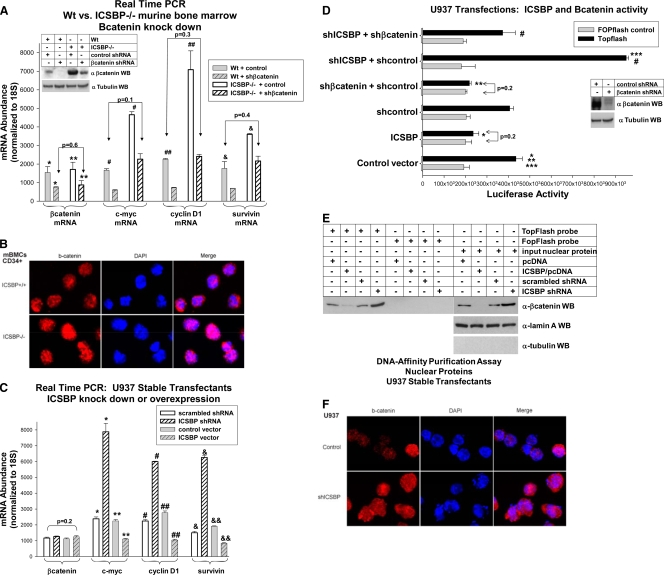FIG. 6.
β-Catenin activity is decreased by ICSBP overexpression and increased by ICSBP deficiency in myeloid progenitor cells. (A) The expression of β-catenin (Bcatenin) target gene mRNA is increased in ICSBP−/− murine myeloid progenitors in comparison to its expression in WT cells, but that of β-catenin mRNA is not altered. Myeloid progenitor cells were isolated from WT or ICSBP−/− mice and cultured in GM-CSF, IL-3, and SCF. Cells were transduced with a retroviral vector to express a β-catenin-specific shRNA or scrambled shRNA control. The levels of expression of mRNA for β-catenin and β-catenin target genes (c-myc, cyclin D1, and survivin) were determined by real-time PCR. The results were normalized to those for 18S RNA. * or **, statistically significant decrease in β-catenin mRNA in WT or ICSBP−/− cells expressing β-catenin-specific shRNA (versus control), respectively; #, ##, or &, statistically significant increase in the expression of c-myc, cyclin D1, or survivin, respectively, in ICSBP−/− control cells in comparison to their expression in WT cells (P < 0.01, n = 3). The lack of a significant difference in c-myc, cyclin D1, or survivin mRNA in WT control cells versus ICSBP−/− cells with β-catenin-specific shRNA is indicated by the arrows (P > 0.1, n = 3). The effect of β-catenin-specific shRNA expression on β-catenin protein expression in these cells is indicated by the results in the inset Western blot. (B) Increased β-catenin (b-catenin) protein is present in the nucleus of ICSBP−/− myeloid progenitors in comparison to the amount in WT cells. Bone marrow was harvested from WT and ICSBP−/− mice, and myeloid progenitor cells were selected and stained with an antibody to β-catenin. β-Catenin staining (red) was compared to staining of the nuclei with DAPI (blue) by confocal microscopy. Nuclear β-catenin is purple/pink in the images. (C) The levels of expression of β-catenin target gene mRNA are decreased by ICSBP overexpression and increased by ICSBP knockdown in U937 myeloid leukemia cells, but that of β-catenin mRNA is not altered. U937 cells were stably transfected with a vector to overexpress ICSBP or the empty control vector or with a vector to express an ICSBP-specific shRNA or scrambled control shRNA. The expression of mRNA for β-catenin or β-catenin target genes (c-myc, cyclin D1, or survivin) was determined by real-time PCR. The results were normalized to those for 18S RNA. *, #, or &, statistically significant increase in c-myc, cyclin D1, or survivin mRNA, respectively, with ICSBP knockdown (P < 0.001, n = 6); **, ##, or &&, statistically significant decrease in expression of c-myc, cyclin D1, or survivin, respectively, due to ICSBP overexpression (P < 0.0002, n = 6). The lack of a difference in β-catenin mRNA expression under all of these conditions is indicated by the bracket (P = 0.2, n = 6). (D) The activity of a β-catenin-binding reporter construct is increased by ICSBP knockdown and decreased by ICSBP overexpression in U937 myeloid cells. U937 cells were cotransfected with a β-catenin activated reporter vector (TOPflash) or its mutant control (FOPflash) and a vector to overexpress ICSBP or the empty vector control. Other U937 cells were cotransfected with the TOPflash or FOPflash reporter vectors, a vector to express an ICSBP-specific shRNA or scrambled shRNA control, or a vector to express a β-catenin-specific shRNA or scrambled shRNA control. * or **, statistically significant decrease in TOPflash reporter activity with ICSBP overexpression or β-catenin-specific shRNA expression, respectively (P < 0.01, n = 4); ***, statistically significant increase in TOPflash activity with expression of ICSBP-specific shRNA (P < 0.002, n = 4); #, statistically significant decrease in TOPflash activity in cells with ICSBP knockdown with expression of β-catenin-specific shRNA versus the control (P < 0.005, n = 4). Complete knockdown of β-catenin by the specific shRNA under these conditions is indicated by the results in the inset Western blot (WB). (E) ICSBP overexpression decreases and ICSBP knockdown increases β-catenin DNA-binding activity in the nucleus of U937 myeloid leukemia cells. Nuclear proteins were isolated from the stable U937 transfectants with ICSBP knockdown or overexpression. Proteins were purified by affinity to biotin-labeled oligonucleotide probes with either a β-catenin DNA-binding site or a mutant, nonbinding sequence. Purified proteins were analyzed by probing Western blots with antibody to β-catenin. To control for protein content in these nuclear fractions, Western blots of these proteins (1/10 the amount used for affinity purification) were probed with antibodies to β-catenin, lamin A (as a nuclear protein loading control), and tubulin (as a cytoplasmic protein loading control). (F) Increased β-catenin staining is present in the nucleus of U937 cells with ICSBP knockdown compared to the staining in control cells. Stable U937 transfectants with an ICSBP-specific shRNA or scrambled control shRNA were stained with an antibody to β-catenin. β-Catenin staining (red) was compared to staining of the nuclei with DAPI (blue) by confocal microscopy. Nuclear β-catenin stains are purple/pink in these images. Error bars indicate standard errors.

